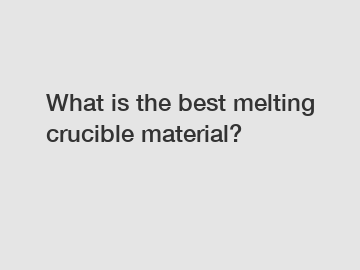What is the best melting crucible material?
When it comes to melting metals and other materials in a crucible, the choice of material for the crucible itself is crucial. The right material can make a significant difference in the quality of the melt and the longevity of the crucible. But with so many options available, which material is the best for melting crucibles?
There are several materials commonly used for crucibles, each with its own advantages and disadvantages. Some of the most popular choices include graphite, clay/graphite, silicon carbide, and ceramic. Each material has unique properties that make it suitable for specific applications.
Graphite is one of the most common materials used for crucibles. It has excellent thermal conductivity, making it ideal for melting metals at high temperatures. Graphite crucibles are also durable and can withstand repeated heating and cooling cycles without cracking or breaking. Additionally, graphite is relatively inexpensive compared to other materials, making it a cost-effective option for many applications.

Another popular choice is clay/graphite crucibles, which combine the thermal conductivity of graphite with the durability of clay. These crucibles are a good compromise for applications where both thermal shock resistance and heat transfer are important. They are commonly used for melting non-ferrous metals like aluminum and brass.
Silicon carbide crucibles are known for their high thermal conductivity and resistance to thermal shock. They can withstand extremely high temperatures, making them suitable for melting high-melting-point metals like steel and titanium. However, silicon carbide crucibles are more expensive than graphite or clay/graphite crucibles and can be prone to cracking if not handled properly.
Ceramic crucibles are another option for melting crucibles. They are lightweight and have good resistance to thermal shock. Ceramic crucibles are typically used for low-temperature applications where high thermal conductivity is not necessary. They are also chemically inert, making them suitable for melting reactive metals.
So, which material is the best melting crucible material? The answer depends on the specific requirements of your application. If you are melting non-ferrous metals at high temperatures, graphite or clay/graphite crucibles may be the best choice. If you are working with high-melting-point metals or need superior thermal shock resistance, silicon carbide crucibles may be more suitable. For low-temperature applications or when chemical resistance is important, ceramic crucibles may be the best option.
In addition to the material of the crucible, it is also important to consider the shape and size of the crucible. Different shapes and sizes are available to accommodate various melting processes and quantities of material. It is essential to choose a crucible that is the right size for your melting needs and that has the appropriate shape for efficient heat transfer.
It is also crucial to properly preheat and season your crucible before use to prevent cracking and improve the longevity of the crucible. Preheating the crucible slowly and evenly can help reduce thermal shock and ensure a consistent temperature throughout the crucible. Seasoning the crucible with a coating of borax or other flux can also help protect the crucible from chemical reactions and extend its lifespan.
In conclusion, the best melting crucible material depends on the specific requirements of your application. Graphite and clay/graphite crucibles are excellent choices for melting non-ferrous metals at high temperatures, while silicon carbide crucibles are ideal for high-melting-point metals and superior thermal shock resistance. Ceramic crucibles are suitable for low-temperature applications and chemical resistance. It is essential to consider the material, shape, and size of the crucible, as well as proper preheating and seasoning, to ensure successful melting processes and extend the life of your crucible.
For more 3 Inch Crucible, graphite blocks customized, What Are Graphite Blocks Used For?information, please contact us. We will provide professional answers.

